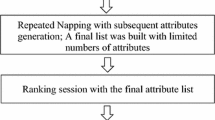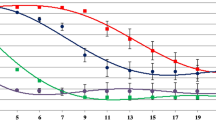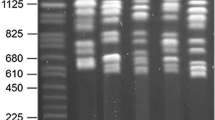Abstract
The purposes of the present study were to evaluate the volatile compounds and sensory characteristics of young red wines produced by spontaneous and inoculated fermentations of Karalahna (KL) and Cabernet Sauvignon (CS) grapes and to identify the yeasts responsible for spontaneous fermentation by molecular methods. A total of 28 volatile compounds in KL wines and 35 compounds in CS wines were identified and quantified by GC–MS. The concentration of higher alcohols and esters differed significantly among spontaneously fermented and inoculated wines. Spontaneous fermentation resulted in greater amount of higher alcohols in KL wines, while inoculated wines had greater amount of higher alcohols in CS wines. Spontaneously fermented KL and CS wines showed greater amounts of esters than inoculated wines. KL wines obtained by spontaneous fermentation had significantly higher scores than inoculated wines based on fruity and green aromas, body and overall impression. Spontaneously fermented CS wines were found significantly higher in fruity and floral aromas than inoculated wines.


Similar content being viewed by others
References
Blanco P, Mirás-Avalos JM, Pereira E, Orriols I (2013) Fermentative aroma compounds and sensory profiles of Godello and Albariño wines as influenced by Saccharomyces cerevisiae yeast strains. J Sci Food Agric 93:2849–2857
Morales ML, Fierro-Risco J, Callejon RM, Paneque P (2017) Monitoring volatile compounds production throughout fermentation by Saccharomyces and non- Saccharomyces strains using headspace sorptive extraction. J Food Sci Technol 54:538–557
Varela C, Siebert T, Cozzolino D et al (2009) Discovering a chemical basis for differentiating wines made by fermentation with “wild” indigenous and inoculated yeasts: role of yeast volatile compounds. Aust J Grape Wine Res 15:238–248
Pretorius IS (2000) Tailoring wine yeast for the new millennium: novel approaches to the ancient art of winemaking. Yeast 16:675–729
Romano P, Fiore C, Paraggio M et al (2003) Function of yeast species and strains in wine flavour. Int J Food Microbiol 86:169–180
Jolly NP, Varela C, Pretorius IS (2014) Not your ordinary yeast: non-Saccharomyces yeasts in wine production uncovered. FEMS Yeast Res 14:215–237
Liu PT, Lu L, Duan CQ, Yan GL (2016) The contribution of indigenous non-Saccharomyces wine yeast to improved aromatic quality of Cabernet Sauvignon wines by spontaneous fermentation. LWT Food Sci Technol 71:356–363
Tristezza M, Vetrano C, Bleve G et al (2012) Autochthonous fermentation starters for the industrial production of Negroamaro wines. J Ind Microbiol Biotechnol 39:81–92
Patrignani F, Montanari C, Serrazanetti DI et al (2017) Characterisation of yeast microbiota, chemical and sensory properties of organic and biodynamic Sangiovese red wines. Ann Microbiol 67:99–109
Renault P, Coulon J, de Revel G et al (2015) Increase of fruity aroma during mixed T. delbrueckii/S. cerevisiae wine fermentation is linked to specific esters enhancement. Int J Food Microbiol 207:40–48
Varela C (2016) The impact of non-Saccharomyces yeasts in the production of alcoholic beverages. Appl Microbiol Biotechnol 100:9861–9874
Whitener MEB, Stanstrup J, Carlin S et al (2017) Effect of non-Saccharomyces yeasts on the volatile chemical profile of Shiraz wine. Aust J Grape Wine Res 23:179–192
OIV (2019) Compendium of international methods of wine and must analysis. International Organisation of Vine and Wine. Paris, France
González SS, Barrio E, Querol A (2007) Molecular identification and characterization of wine yeasts isolated from Tenerife (Canary Island, Spain). J Appl Microbiol 102:1018–1025
Lopandic K, Tiefenbrunner W, Gangl H et al (2008) Molecular profiling of yeasts isolated during spontaneous fermentations of Austrian wines. FEMS Yeast Res 8:1063–1075
Esteve-Zarzoso B, Belloch C, Uruburu F, Querol A (1999) Identification of yeasts by RFLP analysis of the 5.8S rRNA gene and the two ribosomal internal transcribed spacers. Int J Syst Bacteriol 49:329–337
Capece A, Romaniello R, Siesto G et al (2010) Selection of indigenous Saccharomyces cerevisiae strains for Nero d’Avola wine and evaluation of selected starter implantation in pilot fermentation. Int J Food Microbiol 144:187–192
Jeyaram K, Singh WM, Capece A, Romano P (2008) Molecular identification of yeast species associated with ‘Hamei’—a traditional starter used for rice wine production in Manipur, India. Int J Food Microbiol 124:115–125
Van Den Dool H, Kratz PD (1963) A generalization of the retention index system including linear temperature programmed gas—liquid partition chromatography. J Chromatogr A 11:463–471
Meilgaard MC, Civille GV, Carr BT (2007) Sensory Evaluations Techniques. CRC Press, Boca Raton, FL
Fleet GH (2003) Yeast interactions and wine flavour. Int J Food Microbiol 86:11–22
Rodrigues N, Gonçalves G, Pereira-Da-Silva S et al (2001) Development and use of a new medium to detect yeasts of the genera Dekkera/Brettanomyces. J Appl Microbiol 90:588–599
Mannazzu I, Clementi F, Ciani M (2002) Strategies and criteria for the isolation and selection of autochthonous starters. In: Ciani M (ed) Biodiversity and Biotechnology of Wine Yeasts. Res Signpost, Kerala, India, pp 19–33
Albertin W, Miot-Sertier C, Bely M et al (2014) Oenological prefermentation practices strongly impact yeast population dynamics and alcoholic fermentation kinetics in Chardonnay grape must. Int J Food Microbiol 178:87–97
Ribéreau-Gayon P, Glories Y, Maujean A, Dubourdieu D (2006) Handbook of enology, the chemistry of wine stabilization and treatments, 2nd edn. Wiley, Wiltshire
Cai J, Zhu BQ, Wang YH et al (2014) Influence of pre-fermentation cold maceration treatment on aroma compounds of Cabernet Sauvignon wines fermented in different industrial scale fermenters. Food Chem 154:217–229
Jiang B, Xi Z, Luo M, Zhang Z (2013) Comparison on aroma compounds in Cabernet Sauvignon and Merlot wines from four wine grape-growing regions in China. Food Res Int 51:482–489
Garde-Cerdan T, Ancin-Azpilicueta C (2006) Contribution of wild yeasts to the formation of volatile compounds in inoculated wine fermentations. Eur Food Res Technol 222:15–25
Liang HY, Chen JY, Reeves M, Han BZ (2013) Aromatic and sensorial profiles of young Cabernet Sauvignon wines fermented by different Chinese autochthonous Saccharomyces cerevisiae strains. Food Res Int 51:855–865
Jackson RS (2008) Wine science: principles and applications, 3rd edn. Academic Press, Burlington, MA, USA
Saerens SMG, Delvaux F, Verstrepen KJ et al (2008) Parameters affecting ethyl ester production by Saccharomyces cerevisiae during fermentation. Appl Environ Microbiol 74:454–461
Francesca N, Sannino C, Settanni L et al (2014) Microbiological and chemical monitoring of Marsala base wine obtained by spontaneous fermentation during large-scale production. Ann Microbiol 64:1643–1657
Puertas B, Jimenez-Hierro MJ, Cantos-Villar E et al (2018) The influence of yeast on chemical composition and sensory properties of dry white wines. Food Chem 253:227–235
Perestrelo R, Fernandes A, Albuquerque FF et al (2006) Analytical characterization of the aroma of Tinta Negra Mole red wine: identification of the main odorants compounds. Anal Chim Acta 563:154–164
Crandles M, Reynolds AG, Khairallah R, Bowen A (2015) The effect of yeast strain on odor active compounds in Riesling and Vidal blanc icewines. LWT Food Sci Technol 64:243–257
Carrau FM, Boido E, Dellacassa E (2008) Terpenoids in grapes and wines: origin and micrometabolism during the vinification process. Nat Prod Commun 3:577–592
Takush DG, Osborne JP (2012) Impact of yeast on the aroma and flavour of Oregon Pinot Noir wine. Aust J Grape Wine Res 18:131–137
Sadoudi M, Tourdot-Maréchal R, Rousseaux S et al (2012) Yeast-yeast interactions revealed by aromatic profile analysis of Sauvignon Blanc wine fermented by single or co-culture of non-Saccharomyces and Saccharomyces yeasts. Food Microbiol 32:243–253
Soares RD, Welke JE, Nicolli KP, Zanus M, Caramão EB, Manfroi V, Zini CA (2015) Monitoring the evolution of volatile compounds using gas chromatography during the stages of production of Moscatel sparkling wine. Food Chem 291–304
Tao YS, Li H (2009) Active volatiles of Cabernet Aauvignon wine from Changli County. Health 1(3):176–182
Acknowledgements
This work was supported by “The Scientific and Technological Research Council of Turkey” (Grant# 114O431). We would like to thank Vinero Vinery (Çanakkale, Turkey) for their valuable support for winemaking process.
Author information
Authors and Affiliations
Corresponding author
Ethics declarations
Conflict of interest
The authors declare that they have no conflict of interest.
Compliance with ethics requirements
The authors have no conflicts of interest and that sensory testing with human subjects was conducted with appropriate informed consent.
Additional information
Publisher's Note
Springer Nature remains neutral with regard to jurisdictional claims in published maps and institutional affiliations.
Electronic supplementary material
Below is the link to the electronic supplementary material.
Rights and permissions
About this article
Cite this article
Çelebi Uzkuç, N.M., Şişli, B., Ay, M. et al. Effects of spontaneous fermentation on Karalahna and Cabernet Sauvignon young red wines: volatile compounds, sensory profiles and identification of autochthonous yeasts. Eur Food Res Technol 246, 81–92 (2020). https://doi.org/10.1007/s00217-019-03395-w
Received:
Revised:
Accepted:
Published:
Issue Date:
DOI: https://doi.org/10.1007/s00217-019-03395-w




